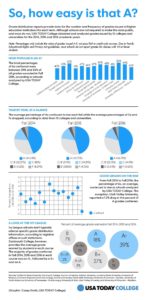(Story is being migrated to USA TODAY general site)
WHAT DOES IT REALLY MEAN when you get an A?
It’s the most popular grade received by college students across the country, and the number of A’s is continuing to rise, according to Stuart Rojstaczer, a former Duke University professor and founder of GradeInflation.com.
The average GPA at four-year colleges and universities rose from 2.52 in the 1950s to 3.11 in 2006, and today, Rojstaczer said close to 50% of the grades given are A’s.
“Grades are a bit like currency, so it’s not surprising that there is a tendency for grades to inflate over time,” Rojstaczer said. “But students are inclined to not take school seriously when they know they can get a B or better with little or no work.”
This phenomenon isn’t new. Rojstaczer says grade inflation became more prevalent during the Vietnam War era, when students who dropped out of college were drafted into the Army. As a result, professors awarded higher grades to prevent students from being deployed.

But now, A’s are three times more common than they were in 1960.
Liz Miller, a honors student at Indiana University, said she has received mostly A’s in college, even at times when she wasn’t sure that it was the grade she “probably should have earned” for her work.
“I don’t think an A goes the same for all classes,” she said. “A lot of times it depends on who the professor is and what department they’re from, and it also depends on how well you can put in what I sometimes consider to be the ‘minimal A-worthy effort’ for certain courses.”
Miller, a rising senior, said she still strives for A’s, and she partially attributes grade inflation to “the willingness” students have to make better connections with professors and their attentiveness to their grades.
“I think it’s safe to say that no one wants C’s or D’s, and honestly, getting a B is even a let down for a lot of students, I would say,” Miller said. “I think A’s should be earned, and I think more often than not they are, but there are definitely different things that I think can influence students getting more A’s than they did in the past.”
There’s a pretty clear trend: At four-year schools, awarding of A’s has been going up five to six percentage points per decade, and grade point averages at four-year colleges are also rising at the rate of 0.1 points per decade.
And grade inflation is more prevalent at private institutions than at public ones. According to Rojstaczer, the mean GPA for both private and public schools in the 1930s was 2.3, or a C+. That number for both types of institutions increased at the same rate until recently – today, the average GPA at private colleges is 3.3 (a B+), while at public universities it’s 3.0 (a B).
Although the meaning behind an A still varies at different schools, Rojstaczer said receiving high marks could mean anything from “you showed up for class and didn’t insult the professor” to “you’re a good to excellent student.”
“Professors should reserve A’s for excellent performance and award F’s for awful performance,” Rojstaczer said. “The percentage of professors who actually grade this way is tiny. The percentage of professors who claim to grade this way is much larger.”
According to a 2013 study conducted by the University of North Texas’s Department of Economics, class size may be one factor in the grade inflation increase, and departments with smaller student-faculty ratios have a greater tendency to exaggerate grades.
The type of degree program could also influence the extent to which professors overstate students’ grades: inflation was more prevalent among Ph.D. departments than it was among lower-level programs, according to the study.
Student evaluations could also incentivize instructors to issue higher grades than they deserve in an effort to “buy” higher evaluation scores, Rojstaczer said: “Professors believe that if they grade easier, they’ll receive high course evaluation ratings, so they grade easier.”
Rojstaczer added that at a handful of schools, administrators apply pressure to keep grade inflation in check, and “that pressure works.”
Jay Brown, a senior at Louisiana State University expecting to graduate magna cum laude this summer, said he thinks receiving better grades “might be an issue,” although he’s hoping to use the benefits from his good grades to “do more than most” after he graduates.”
“The more A’s you have, the more likely you are to go to grad school or get a better job,” he said. “I didn’t want to just pass my classes — I jumped through hoops so I could have these better opportunities.”
Despite theories about why grades awarded by professors continues to improve, Brown said he believes it could also be attributed to “students getting smarter.”
“I think students, including myself, are putting in more effort and they’re trying harder to get As,” he said. “There might be more As going to college students, but I think part of it can be linked to students getting smarter and smarter than they were before.”
But Terrel Rhodes, vice president for the office of quality, curriculum and assessment at the Association of American Colleges and Universities (AACU), said if grade inflation is an underperformance problem, it’s likely because educators aren’t asking students to do the “kinds and levels of work” being asked of graduates in the job field.
“Grades are used because they are a familiar representation that reduces the complexity of learning and its multi-faceted pieces to a quick indicator,” Rhodes said. “But it too often does not provide a very good representation of what a student can actually do with their learning.”
AACU is one of the leaders of the VALUE Project, which aims to have faculty members compare standards for various programs with the goal of “common, faculty-driven expectations about learning outcomes.”
Rhodes said based on current data from the VALUE work, schools could benefit from moving away from reliance on “grades alone” and instead link course grade performance to examples of “the work students have actually done.”
